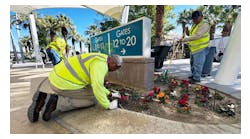As the U.S. population ages and the Americans with Disabilities Act lowers barriers, airports have become one of the places where you are most likely to encounter someone with a physical disability, whether sitting alone or among a cluster of travelers awaiting assistance to their gates. Indeed, airports – like virtually all public venues - have continued to play a catch-up game with this growth of the traveling public. The Census Bureau estimates some 56 million citizens live with a disability and a third of that number involves a physical disability – people who are blind or visually impaired, deaf or hard of hearing, or mobility impaired. As this population group has moved into the travel mainstream, airport managers have turned to one of two pathways to ease the challenges faced by its members in Navigating airports and to moderate the operational challenges presented by the growing number of wheelchair users, Guide dog handlers and other consumers: customer service and design.
Customer Service
Airports are hardly places where people stop to contemplate design, but travelers are certainly aware of how customer service impacts their experience. As a blind traveler, I can testify that it’s an odd feeling to find myself part of a group that, about to fly around the world ,can’t traverse an airport without the aid of someone else. Unfortunately, the interactions so many disabled travelers have as we proceed through the entire airport experience often leaves us feeling shaken, angry and diminished. That’s because along the way we encounter a string of airport, airline and even TSA employees who have had inadequate training and preparation for working with people with disabilities. Ours Is too often an experience of ricocheting hand-offs, starting perhaps with a curbside check-in encounter and concluding with finally being seated on our flight, where we are instructed to remain seated in the event of an emergency until all other passengers have been evacuated. In between, we will likely interact with a ticket agent, a supervisor to guides, a guide, several TSA agents, gate attendants and flight attendants. Some may be adequately prepared and easy to work with, but most will not make the grade. (Only a small percentage of ticketing kiosks are accessible to blind users.)
his leads us back to that cluster of travelers sitting in what feels like an ad-hoc corner of the ticketing area awaiting assistance. These folks may be traveling with companions, yet even those companions – family members, business associates, friends or paid caregivers – may want to rely on the service that airports provide people with disabilities to get where they need to go.
Some members of this group may not view themselves as having a disability, but due to circumstances such as age-related fatigue,,,, poor physical condition or a passing infirmity, they have recognized, however grudgingly, that they need help. Thus, they find themselves – as I often do as a blind traveler - sitting among a random group of strangers in wheelchairs, with white canes or guide dogs or with less visible disabilities, waiting for a harried superviser to reach through her walkie-talkie and pull out an able-bodied person capable of walking them through security to their point of departure. Once they succeed at that task, the guide that arrives can turn out to be anyone from a sprightly and companionable young person to a heavy-set senior with their own mobility challenges. Often, language barriers exist.
It’s the same on the other end of your trip. Upon deplaning, there is frequently a long wait to locate an available guide, and that guide may be tasked with leading several travelers simultaneously to a range of destinations, including connecting flights, baggage claim and ground transportation. Either way, it is almost never a pleasant experience and contributes to the frustration and anxiety that sometimes envelope the airport consumer.
This condition needs to change direction, because it will only deteriorate if left unaddressed. And change needs to be driven from the top . Leaders of airport authorities , airlines and even the TSA need to work collaboratively to crate uniform minimum customer service standards that will ensure that all face-to-face interactions, from Redcaps to pilots – share some basics abou the new population they are serving. Of course, it’s nhot a new population, but to date its gaining market presence has been addressed by looking backwards and fixing a problem that existed in an earlier time frame but has since morphed into something more powerful and ever-present.
But who will take the lead in bringing together these stakeholders? This is not an occasion for a turf war, because the endgame will serve all customers, including people with disabilities.
As any hotel executive knows, even the most limited-service hotel property will be well remembered for great customer service – and even the most luxurious five-star hotel will leave guests with a sour taste if service doesn’t measure up to surroundings and reputation.
It is true that airports don’t answer to the same competitive equation that hotels need to address. Few markets really offer choice in air travel terminals. But safety, security and ease of travel all matter in the extreme to every traveler, regardless of how constrained they are by physical circumstance.
Design
A number of technologies are being developed to aid blind and visually impaired as well as deaf and hard of hearing travelers to navigate independently through concourses. Innovations such as beacons that transmit location- or direction-related information to blind people through smart phone apps are being tested and improved upon, and this will certainly assist many travelers to find their way on their own. However, not everyone is as adept at learning how to use such technology, and it will be decades before the millennials that were born with iPhones in hand will dominate the travelscape. Older travelers – and some 10,000 people a day will turn 65between now and 2030 – need real, rather than virtual design elements to enhance their positive experience of airport environments. .
I recently engaged these questions on the Runway-VC podcast hosted by Chris Groh, along with architect specializing in aviation from the Dallas office of Corgan Architects, Scott Gorenc. The freewheeling discussion can be found at http://www.runway.vc/podcasts/rnwyvc-12
Among the design strategies that Corgan uses to make sure that its architects understand the wide range of passenger types and the differing challenges and obstacles they face while coursing through the terminals were what Gorenc referred to as “empathy tools.” These devices mimic certain physical conditions to help the designer better understand the problems that need to be solved. For example, a glove might generate a constant tremor in the wearer’s hand, as someone with Parkinson’s disease might experience, or an aging simulator complete with heavy boots that will impose a slower walking pace. There are also lenses that allow the wearer to experience different types of sight loss, and sound-canceling headphones. Corgon also employs evidence-based tools, including lenses that capture exactly where the user is directing their gaze – mostly downward, it turns out, whichpoints to floor patterning as akey wayfinding tool. Changing floor textures can also help blind people navigate, and Gorenc noted that minor modulations to grade – i.e., a gentle slope – eases the path for wheelchair users and their companions.
Of course, travelers without life-altering disabilities don’t necessarily love navigating terminals. To state the obvious, design improvements that make life simpler for disabled travelers do the same for all travelers. Unfortunately, the reverse is simply not true, and the design world and the aviation world have both been slow to recognize this. Reconfiguring an existing terminal is of course less rewarding and more disruptive than factoring in this understanding from the start of a new terminal or airport. Just as newer airports incorporate TSA and other security concerns from Day One of planning, bringing awareness of the requirements of travelers with disabilities into the mix at the same time will make airports safer and more easy to vavigate for all airport customers and workers – and aviation managers. Not everyone has the opportunity to start from scratch, but even – especially, perhaps – when retrofitting an older facility, beginning with the understanding that it must be inclusive and universally accessible upon reopening will set the stage for successful project.
A positive outcome is always welcome.
But at base, airports and airlines will need to adjust more than technology and design: they will need to work together to rebuild their approach to customer service in general and for customers with disabilities in particular. Without such an adjustment, new technologies and design advancements may improve the physical and environmental aspects of passenger experience, but the social, interactive experience will remain as negative as ever, driving airlines and airports further into the waititing arms of regulators.





